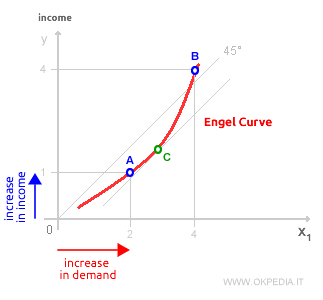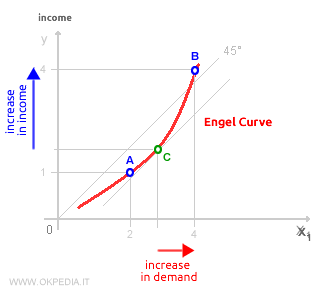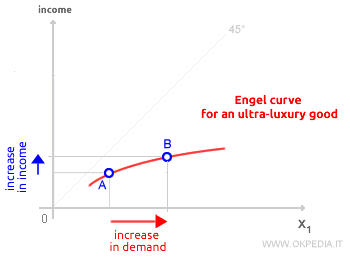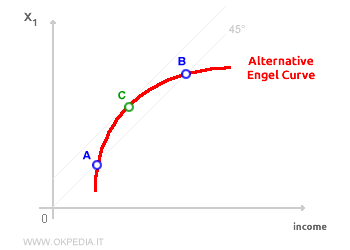Engel Curve
The Engel curve visually represents how market demand for a good changes with income, assuming all other economic variables (such as the price of the good and other prices) remain constant.
Example
In the budget constraint below, we assume that p1 (price of good 1) and p2 (price of good 2) are fixed. However, the variables are income Y and the quantity demanded, x1, of good 1.

This setup allows us to observe how the market demand for the good (x1) changes as income (Y) varies.

In this diagram, we’ve drawn an Engel curve for a normal good, X1.
Understanding the Engel Curve
The Engel curve is derived from the income-consumption curve.
The horizontal axis (X) measures the quantity of good X1, while the vertical axis (Y) shows different levels of the consumer's income.
Note: In some alternative representations, the horizontal axis measures the monetary expenditure, P1X1, for the good instead of the quantity purchased, X1. The meaning of the Engel curve remains unchanged since prices are assumed constant.
In the initial segment of the curve (point A), an income increase leads to a more than proportional rise in demand for good X1.

However, after point C on the Engel curve, an income increase corresponds to a less than proportional rise in demand for good X1.

In this later segment, the consumer tends to allocate more of their income towards purchasing the other good, X2.
The shape and slope of the Engel curve would vary if we considered inferior goods, luxury goods, ultra-luxury goods, perfect substitutes, or perfect complements.
The Case of an Inferior Good
For an inferior good, the Engel curve slopes downward.

As income rises, demand for good X1 decreases.
Example: A classic example of an inferior good is potatoes. They’re a basic, low-cost staple that satisfies hunger. However, as income rises, consumers tend to replace them with more expensive food items (e.g., meat, pasta, etc.).
The Case of an Ultra-Luxury Good
For an ultra-luxury good, the Engel curve slopes upward and is highly elastic.

As income grows, demand for good X1 increases rapidly.
Example: Examples of ultra-luxury goods include high-end luxury items, jewelry, and sports cars. Spending on these goods increases significantly with rising income.
An Alternative Representation of the Engel Curve
In some textbooks and educational resources, the Engel curve can be shown differently, with quantities of good X1 on the vertical axis and consumer income on the horizontal axis, reversing the earlier diagram. For instance, the Engel curve for a normal good can also appear as follows:

In this setup, along segment AC, demand for good X1 rises more than proportionally with income changes, while along segment CB, it increases less than proportionally. This is simply an alternative way to illustrate the same theoretical concept.
 Income Elasticity of Demand: The Engel curve enables us to measure income elasticity of demand on a Cartesian plane. The slope of the Engel curve provides insight into the type of good. Consumption goods are classified as luxury goods if income elasticity of demand is greater than one, meaning demand for the good rises more than proportionally with income growth. Conversely, consumption goods are classified as necessities and inferior goods if elasticity is between zero and one or negative, respectively.
Income Elasticity of Demand: The Engel curve enables us to measure income elasticity of demand on a Cartesian plane. The slope of the Engel curve provides insight into the type of good. Consumption goods are classified as luxury goods if income elasticity of demand is greater than one, meaning demand for the good rises more than proportionally with income growth. Conversely, consumption goods are classified as necessities and inferior goods if elasticity is between zero and one or negative, respectively.
